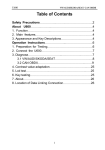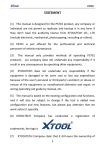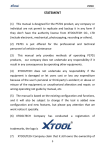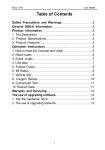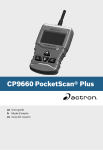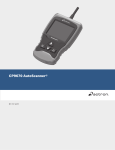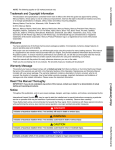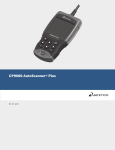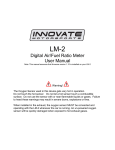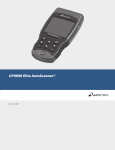Download VAG V-CHECKER SCANNER PROFESSIONAL
Transcript
PS100 OBDII/CAN OBDII Table of Contents Safety Precautions…………….……….…………..…………..2 Tool Description……….………..……………………….……..4 1. Function…………………..……….……………………….…..4 2. Main features………………………..…..……….……………4 3. Appearance and Key Descriptions………………….……….5 Operation Instructions……………….....……………………..6 1. Preparation for Testing…………….………….……………..6 2. Connect the PS100……………….…………..……………….7 3. Diagnose………………..…………..…..…………...…………7 3.1 Read trouble code…………………..…….………….…8 3.2 Erase trouble code.…….…..………….………..……..10 3.3 Live data………………………………..………….……11 3.4 Freeze Frame…………………..……………….……..12 3.5 IM Status…………………………………………….….14 3.6 Vehicle info………………..…………………………...15 3.7 Oxygen Sensor……………………………………..…..16 3.8 Model 6 Test…………………………………….……..18 3.9 EVAP System Test………………………..…………....20 4. Language……………………………………………………..20 5. Contrast adaptation……………………………..………..….21 6. Lcd test…………………..………………………………...….21 7. Key testing…………………………………………………….22 8. Information…………………………………………..………..22 9. Location of DLC…………………………………………..…..22 APPENDIX A…………...………..…………….………………..23 APPENDIX B………….………..……………………………….25 APPENDIX C………………………………..…..………………26 1 www.Xtooltech.com PS100 OBDII/CAN OBDII Safety Precautions To avoid body hurt, damage to the device and to your cars, please read the using instruction of PS100 carefully before you use the device. The common testing process introduced by this instruction is described by the experienced technology service people, many of which require you to take action to avoid possible body hurt, damage to the device or to your car. Please read your car amending instructions and do as it instructs as to ensure safety before or during you test. Please keep attention to the following safety precautions. z When engine running, it generates CO and other poisonous kinds of air. To avoid severe hurt or damage caused by them, please test in a well-ventilated place. z Please wear qualified eye-protecting goggle to avoid your eyes from being hurt by the pushed things or harmful fluid. z When engine running, many parts, for example, coolant fan, pulley and belts of the fan, rotating in high speed. To avoid this kind of hurt, keep caution of these parts. Keep in a safe distance from them and other potentially moving and harmful things. z When engine running, the parts of the engine become very hot. To avoid being heated and even burned, please avoid touching with the parts. z Ensure well install the braking before you test the engine or test the car.. Turn to transmission block (automatic transmission) or neutral transmission (manual transmission).Setback car wheels by proper means. z When the car is ignited, connecting or disconnecting the device to or from the car could destroy the device or car’s electronic parts. Therefore, please disconnect the tool from vehicle’s DLC socket before connecting PS100 or disconnection the PS100. z To not to destroy the on-board computer, you’d have to use a one-number multimeter with at least 10meg impedance when taking vehicle electrical measurements.。 z Fuel and battery vapor are highly flammable. To prevent an explosion, keep all sparks, heated items and open flames untouched with the battery, fuel or fuel vapor. Don’t smoke near the testing location. www.Xtooltech.com 2 PS100 z OBDII/CAN OBDII When working with the engine running, please don’t wear loose clothing or any jewelry because loose clothing can be easily caught by the fan, pulley or belts, while jewelry is highly conductive and they can cause burning hurt once they make contacts between the ground and conductive items. 3 www.Xtooltech.com PS100 OBDII/CAN OBDII 1 Tool Description 1. Function z z z z z z z z PS100 has the following powerful functions: Works on all 1996 and newer cars & light trucks that are OBD II compliant (including the VPW, PWM, ISO, KWP 2000 and CAN protocols) Reads and clears generic and manufacturer specific Diagnostic Trouble Codes (DTCs) Reading Freeze Frame Data Testing I/M Reading Status Reading vehicle info Oxygen sensor test Model 6 test EVAP System Test 2. Main features z Display: Backlit LCD,160*160 pixel display. z Operating Temperature: 0 to 50℃ (﹣32 to 122℉) z External Power: 10.0 to 15.5 vols provided via vehicle battery z Dimensions: 225mm Length 98mm Width 36mm Height z OBDII connector , 1500mm(59.99”) 4 www.Xtooltech.com PS100 OBDII/CAN OBDII 2. Appearance and Key Descriptions The appearance of a PS100 is as shown in the above figure. 1. LCD screen: 160*160 2. Enter key: confirm a selection of a menu list and operate it 3. Esc key: retune to the previous screen 4. Up/down arrow: move the curse up or down 5. Left/right arrow: turn pages 6. Vehicle diagnostic port: OBDII -16PIN 5 www.Xtooltech.com PS100 OBDII/CAN OBDII Operation Instructions 1. Preparation for Testing PS100 can test cars and delete error codes while read the error codes. Meanwhile, there are mechanical problems, such as poor engine performance due to lower fuel level, soft cubes damaged, electrical wire or electrical connections, which will also cause faked error codes. Therefore, you need to refer to car service pamphlet for more details before you test the known mechanical problems. Please check the following items before any test. z Check the engine, power steering fluid, transmission oil (if applicable), engine coolant fluid and other fluid level. If needed, decrease low fluid levels. z Ensure air filter is clear and in good condition. Ensure all air filter connectors run properly. Check air filter for holes, rips and cracks. z Ensure engine belts running well. Check there are not ripped, broken, brittle, loose or lost belts. z Make sure engine sensor (throttle, gearshift position, transmission, etc.) is safe and mechanically right connected. Refer to the location of car service manual. z Make sure engine sensor (throttle, gearshift position, transmission, etc.) is safe and mechanically right connected. Refer to the location of car service manual. z Ensure all spark plugs are clean and in good condition. Check if there are damaged, loose, disconnected or lost spark plug wires. z Ensure battery terminals are clean and tightly connected. Check if there are corroded or damaged connectors. Ensure that the battery and the charging voltages are properly applied. z Check all electrical wires and harasses are correctly connected. Ensure all insulations are in good condition without bared wires. z Ensure the engine mechanically sounds. If necessary, perform a compression test, engine vacuum test, timing test (if applicable) and etc. 6 www.Xtooltech.com PS100 OBDII/CAN OBDII 2. Connect the PS100 2.1 Turn the ignition on. 2.2 Locate the vehicle's 16-pin Data Link Connector (DLC). 2.3 Connect the PS100 cable connector to the vehicle’s DLC. Turn on the ignition, The PS100 will auto start, the following screen will be displayed. z z z z z z [Diagnose]: Diagnose [Language]: To select language [Contrast]: contrast value modification [Display Test]: Lcd test [Keypad Test]:key test [Information]:show edition information 3. Diagnose Choose [Diagnose] and then press [Enter] key. The following menu will be displayed on the screen. Press ENTER key and it displays. 7 www.Xtooltech.com PS100 OBDII/CAN OBDII Enter the system and it displays: 3-1 Read trouble code 1. the trouble codes function read DTCs from the vehicle's computer modules there tow types of codes, Malfunction Indicator Lamp(MIL) Codes and pending codes MIL Codes: These codes cause the computer to illuminate the MIL when an emission related or driveability fault occurs. The MIL is also known as the “service Engine Soon” or “Check Engine Lamp”. MIL codes remain in 8 www.Xtooltech.com PS100 OBDII/CAN OBDII the vehicle’s memory until the fault is repaired. 2. Pending Codes: These codes are also referred as “continuous monitor” and “maturing codes”. An intermittent fault will cause the computer to store a code in memory. If the fault does not occur within 40 warm-up cycles, the code will be cleared from memory. If the fault occurs a specific number of times, the code will mature into a DTC and the MIL will turn on. 3. Select Trouble codes and press ENTER, The PS100 retrives the DTCs stored in the vehicle's computer modules. ▲ ▲ if there are no trouble codes, it will display “No codes in the vehicle!” If there are any trouble codes, all information will be reported on the display Select one of the error codes if there are over 2 error codes by moving up/down key. If there are factory definition error codes the relative information will be reported on the display,You can select the corresponding car model to make sense of the error codes. 9 www.Xtooltech.com PS100 OBDII/CAN OBDII Take operating GM car error codes for example. 3-2 Erase trouble code Select Erase Codes and press the ENTER key. a message appears asking if you are want to erase all the fault codes. 10 www.Xtooltech.com PS100 OBDII/CAN OBDII If you Press ENTER 3-3 Live data 1.Display the live data, 11 www.Xtooltech.com PS100 OBDII/CAN OBDII 2. Live data are reported on the display 3. Using the LEFT /RIGHT arrows to view Live data of the following page monitors. Abbreviated Name for live data specified in Appendix A 3-4 Freeze Frame 1. when an emission-related fault occurs, certain vehicle conditions are recorded by the on-board computer. this information is referred to as a freeze. Frame data. this data can be overwriten by faults with a higher priority. 2. if codes were erased, the freeze frame data may not be stored in vehicle memory. Select Freeze Frame from the menu and press ENTER 12 www.Xtooltech.com PS100 OBDII/CAN OBDII 3. Freeze Frame data are reported on the display 4. Using the LEFT /RIGHT arrows to view Live data of the following page monitors. Abbreviated Name for Freeze Frame specified in Appendix A 13 www.Xtooltech.com PS100 OBDII/CAN OBDII 3-5 IM Status 1. Select I/M Status and press ENTER 2. Using the UP/DOWN arrows to view status of the following monitors. Abbreviated Name -Misfire Monitor -FUEL System Mon -Com Component -Catalyst Mon -Htd Catalyst -Evap System Mon -Sec Air System -A/C Refrig Mon -OXYGEN Sens Mon -Oxygen Sens HTR -EGR System Mon Expanded Name Misfire monitor Fuel System Monitor Comprehensive Components Monitor Catalyst Monitor Heated Catalyst Monitor Evaporative System Monitor Secondary Air System Monitor Air Conditioning Refrigerant Monitor Oxygen Sensor Monitor Oxygen Heater Sensor Monitor Exhaust Gas Recirculation System Monitor 14 www.Xtooltech.com PS100 OBDII/CAN OBDII 3-6 Vehicle info 1. Select “Vehicle info” from the main menu, press the “ENTER” button. 2. Vehicle info are reported on the display. 3. If the vehicle does not support this mode, a message will show " Not supported!" 15 www.Xtooltech.com PS100 OBDII/CAN OBDII 3-7 Oxygen Sensor 1. Select Oxygen Sensor and press ENTER 2. If the vehicle supports this mode, data reported on the display. You can select Oxygen sensor location If the vehicle does not support this mode, a message will show " Not supported!" 16 www.Xtooltech.com PS100 OBDII/CAN OBDII If your vehicle applies to CAN protocol, a message will show. 3. Select Oxygen sensor test id. Abbreviated Name Expanded Name RichToLeSeThV(Con) Rich to lean sensor threshold voltage (constant) LeanToRiSeThV(Con) Lean to rich sensor threshold voltage (constant) LowSeVFoSwTiCA(Con) Low sensor voltage for switch time calculation (constant) HighSeVoFoSwTiCa(Con) High sensor voltage for switch time calculation (constant) RichToLeSwTi(Cal) Rich to lean sensor switch time (calculated) LeanToRiSeSwTi(Cal) Lean to rich sensor switch time (calculated) MinSeVoForTeCy(Cal) Minimum sensor voltage for test cycle (calculated) MaxSeVoForTeCy(Cal) Maximum sensor voltage for test cycle (calculated) TimeBeSeTr(Cal) Time between sensor transitions (calculated) Sensor period(Cal) Sensor period (calculated) 4. Disp test result. 17 www.Xtooltech.com PS100 OBDII/CAN OBDII 3-8 Model 6 Test The purpose of this service is to allow access to the results for on-board diagnostic monitoring tests of specific components / systems that are continuously monitored (e.g., mis-firemonitoring) and non-continuously monitored (e.g., catalyst system). 1. Select Model 6 Test and press ENTER 2. If your vehicle applies to ISO 9141-2, PWM,VPW, and ISO 14230-4, information will be reported on the display 3. Select TID ,then press ENTET 18 www.Xtooltech.com PS100 OBDII/CAN OBDII 4. Disp test result. TID specified in Appendix B If your vehicle applies to ISO 15765-4, information will be reported on the display 19 www.Xtooltech.com PS100 OBDII/CAN OBDII OBDMID and CID specified in Appendix C. 3-9 EVAP System Test FUNCTIONAL DESCRIPTION—The purpose of this service is to enable the external test equipment to control the operation of an on-board system, test or component. 1. Select EVAP System Test and press ENTER 2. There are the following three kinds of test results. a) If it does not support this function, it will show. 20 www.Xtooltech.com PS100 OBDII/CAN OBDII b) If the conditions are not proper to run the test, the vehicle, d"The conditions are not proper to run the test" will display. c) If test succeeds, it shows "Command Sent" 4. Language Choose [language] at the main menu. Then press [Enter]. The screen will display as the following 5. Contrast Adaptation Choose [Contrast] at the main menu. Then press [Enter]. The screen will display as the following. 21 www.Xtooltech.com PS100 OBDII/CAN OBDII Simply press up/down arrow to set and then press [Enter] to confirm. 6. Lcd test Choose[Lcd Test] at the main menu, Press Enter],The screen will display the following dynamic image. 7. Key testing Choose [Keypad Test] at the main menu. Press [Enter]. The screen will display the following interface. Press any key then the screen will flash due to corresponding to your cooperation. Double [Esc], you can withdraw from the testing. 8. Information Choose [About] and then press [Enter]. Then screen will display the version of this device. 22 www.Xtooltech.com PS100 OBDII/CAN OBDII 9. Location of DLC OBD-II 16pin is like the following picture shows. For VW Golf, it usually locates at the right hand direction steering column. For Jetta, it usually locates in the cab on the left bellow the instruction dash; For SANTANA, it locates at the transmission dust cover which is in the front of it.. For more details, please refer to car repairing pamphlet APPENDIX A Abbreviated NAME FOR SERVICE $01 AND $02 SCALING AND DEFINITION Abbreviated Name Expanded Name Fuel Sys1, Fuel Sys2 Fuel system 1 status, Fuel system 1 status: CALC LOAD Calculated LOAD Value COOLANT Engine Coolant Temperature ST FTRM1 Short Term Fuel Trim - Bank 1 LT FTRM1 Long Term Fuel Trim - Bank 1 ST FTRM2 Short Term Fuel Trim - Bank 2 LT FTRM2 Long Term Fuel Trim – Bank 2 FUEL PRES Fuel Rail Pressure (gauge) MAP Intake Manifold Absolute Pressure ENGINE Engine RPM VEH SPEED Vehicle Speed Sensor IGN ADV Ignition Timing Advance for #1 Cylinder IAT Intake Air Temperature MAF Air Flow Rate from Mass Air Flow Sensor ABSLT TPS Absolute Throttle Position SECOND AIR Commanded Secondary Air Status 23 www.Xtooltech.com PS100 OBDII/CAN OBDII O2S Location Location of Oxygen Sensors O2S11 Bank 1 – Sensor 1 O2S12 Bank 1 – Sensor 2 O2S13 Bank 1 – Sensor 3 O2S14 Bank 1 – Sensor 4 O2S21 Bank 2 – Sensor 1 O2S22 Bank 2 – Sensor 2 O2S23 Bank 2 – Sensor 3 O2S24 Bank 2 – Sensor 4 SHRTFT11 Short Term Fuel Trim (Bank 1 – Sensor 1) SHRTFT12 Short Term Fuel Trim (Bank 1 – Sensor 2) SHRTFT13 Short Term Fuel Trim (Bank 1 – Sensor 3) SHRTFT14 Short Term Fuel Trim (Bank 1 – Sensor 4) SHRTFT11 Short Term Fuel Trim (Bank 2 – Sensor 1) SHRTFT12 Short Term Fuel Trim (Bank 2 – Sensor 2) SHRTFT13 Short Term Fuel Trim (Bank 2 – Sensor 3) SHRTFT14 Short Term Fuel Trim (Bank 2 – Sensor 4) OBD2 STAT OBD requirements to which vehicle is designed PTO STATUS Power Take Off (PTO) Status MI Dist. Traveled Distance Travelled While MIL is Activated O2S W.R. EQ_RAT11 O2S W.R. B1,S1 Bank 1 – Sensor 1 (wide range O2S) Equivalence Ratio (lambda) Bank 1 – Sensor 1 (wide range O2S) Oxygen Sensor Voltage O2S W.R. EQ_RAT12 Bank 1 – Sensor 2 (wide range O2S) Equivalence Ratio (lambda) O2S W.R. B1,S2 Bank 1 – Sensor 2 (wide range O2S) Oxygen Sensor Voltage O2S W.R. EQ_RAT13 Bank 1 – Sensor 3 (wide range O2S) Equivalence Ratio (lambda) O2S W.R. B1,S3 Bank 1 – Sensor 3 (wide range O2S) Oxygen Sensor Voltage O2S W.R. EQ_RAT14 Bank 1 – Sensor 4 (wide range O2S) Equivalence Ratio (lambda) O2S W.R. B1,S4 Bank 1 – Sensor 4 (wide range O2S) Oxygen Sensor Voltage O2S W.R. EQ_RAT21 Bank 2 – Sensor 1 (wide range O2S) Equivalence Ratio (lambda) O2S W.R. B2,S1 Bank 2 – Sensor 1 (wide range O2S) Oxygen Sensor Voltage O2S W.R. EQ_RAT22 Bank 2 – Sensor 2 (wide range O2S) Equivalence Ratio (lambda) O2S W.R. B2,S2 Bank 2 – Sensor 2 (wide range O2S) Oxygen Sensor Voltage O2S W.R. EQ_RAT23 Bank 2 – Sensor 3 (wide range O2S) Equivalence Ratio (lambda) O2S W.R. B2,S3 Bank 2 – Sensor 3 (wide range O2S) Oxygen Sensor Voltage O2S W.R. EQ_RAT24 Bank 2 – Sensor 4 (wide range O2S) Equivalence Ratio (lambda) O2S W.R. B2,S4 Bank 2 – Sensor 4 (wide range O2S) Oxygen Sensor Voltage O2S W.R. EQ_RAT11 Bank 1 – Sensor 1 (wide range O2S) Equivalence Ratio (lambda) O2S W.R. B1,S1 Bank 1 – Sensor 1 (wide range O2S) Oxygen Sensor Voltage O2S W.R. EQ_RAT12 Bank 1 – Sensor 2 (wide range O2S) Equivalence Ratio (lambda) //24-2b 0x1d O2S W.R. B1,S2 Bank 1 – Sensor 2 (wide range O2S) Oxygen Sensor Voltage O2S W.R EQ_RAT13 Bank 2 – Sensor 1 (wide range O2S) Equivalence Ratio (lambda) 24 www.Xtooltech.com PS100 OBDII/CAN OBDII O2S W.R. B1,S3 Bank 2 – Sensor 1 (wide range O2S) Oxygen Sensor Voltage O2S W.R. EQ_RAT14 Bank 2 – Sensor 2 (wide range O2S) Equivalence Ratio (lambda) O2S W.R. B1,S4 Bank 2 – Sensor 2 (wide range O2S) Oxygen Sensor Voltage O2S W.R. EQ_RAT21 Bank 3 – Sensor 1 (wide range O2S) Equivalence Ratio (lambda) O2S W.R. B2,S1 Bank 3 – Sensor 1 (wide range O2S) Oxygen Sensor Voltage O2S W.R. EQ_RAT22 Bank 3 – Sensor 2 (wide range O2S) Equivalence Ratio (lambda) O2S W.R. B2,S2 Bank 3 – Sensor 2 (wide range O2S) Oxygen Sensor Voltage O2S W.R. EQ_RAT23 Bank 4 – Sensor 1 (wide range O2S) Equivalence Ratio (lambda) O2S W.R. B2,S3 Bank 4 – Sensor 1 (wide range O2S) Oxygen Sensor Voltage O2S W.R. EQ_RAT24 Bank 4 – Sensor 2 (wide range O2S) Equivalence Ratio (lambda) O2S W.R. B2,S4 Bank 4 – Sensor 2 (wide range O2S) Oxygen Sensor Voltage O2S W.R. EQ_RAT11 Bank 1 – Sensor 1 (wide range O2S) Equivalence Ratio (lambda) O2S W.R. B1,S1 Bank 1 – Sensor 1 (wide range O2S) Oxygen Sensor Current O2S W.R. EQ_RAT12 Bank 1 – Sensor 2 (wide range O2S) Equivalence Ratio (lambda) O2S W.R. B1,S2 Bank 1 – Sensor 2 (wide range O2S) Oxygen Sensor Current O2S W.R. EQ_RAT13 Bank 1 – Sensor 3 (wide range O2S) Equivalence Ratio (lambda) O2S W.R. B1,S3 Bank 1 – Sensor 3 (wide range O2S) Oxygen Sensor Current O2S W.R. EQ_RAT14 Bank 1 – Sensor 4 (wide range O2S) Equivalence Ratio (lambda) O2S W.R. B1,S4 Bank 1 – Sensor 4 (wide range O2S) Oxygen Sensor Current O2S W.R EQ_RAT21 Bank 2 – Sensor 1 (wide range O2S) Equivalence Ratio (lambda) O2S W.R B2,S1 Bank 2 – Sensor 1 (wide range O2S) Oxygen Sensor Current O2S W.R. EQ_RAT22 Bank 2 – Sensor 2 (wide range O2S) Equivalence Ratio (lambda) O2S W.R. B2,S2 Bank 2 – Sensor 2 (wide range O2S) Oxygen Sensor Current O2S W.R. EQ_RAT23 Bank 2 – Sensor 3 (wide range O2S) Equivalence Ratio (lambda) O2S W.R. B2,S3 Bank 2 – Sensor 3 (wide range O2S) Oxygen Sensor Current O2S W.R. EQ_RAT24 Bank 2 – Sensor 4 (wide range O2S) Equivalence Ratio (lambda) O2S W.R. B2,S4 Bank 2 – Sensor 4 (wide range O2S) Oxygen Sensor Current O2S W.R. EQ_RAT11 Bank 1 – Sensor 1 (wide range O2S) Equivalence Ratio (lambda) O2S W.R. B1,S1 Bank 1 – Sensor 1 (wide range O2S) Oxygen Sensor Current O2S W.R. EQ_RAT12 Bank 1 – Sensor 2 (wide range O2S) Equivalence Ratio (lambda) O2S W.R. B1,S2 Bank 1 – Sensor 2 (wide range O2S) Oxygen Sensor Current O2S W.R. EQ_RAT21 Bank 2 – Sensor 1 (wide range O2S) Equivalence Ratio (lambda) O2S W.R. B2,S1 Bank 2 – Sensor 1 (wide range O2S) Oxygen Sensor Current O2S W.R. EQ_RAT22 Bank 2 – Sensor 2 (wide range O2S) Equivalence Ratio (lambda) O2S W.R. B2,S2 Bank 2 – Sensor 2 (wide range O2S) Oxygen Sensor Current O2S W.R EQ_RAT31 Bank 3 – Sensor 1 (wide range O2S) Equivalence Ratio (lambda) O2S W.R B3,S1 Bank 3 – Sensor 1 (wide range O2S) Oxygen Sensor Current O2S W.R. EQ_RAT32 Bank 3 – Sensor 2 (wide range O2S) Equivalence Ratio (lambda) O2S W.R. B3,S2 Bank 3 – Sensor 2 (wide range O2S) Oxygen Sensor Current O2S W.R. EQ_RAT41 Bank 4 – Sensor 1 (wide range O2S) Equivalence Ratio (lambda) O2S W.R. B4,S1 Bank 4 – Sensor 1 (wide range O2S) Oxygen Sensor Current O2S W.R. EQ_RAT42 Bank 4 – Sensor 2 (wide range O2S) Equivalence Ratio (lambda) O2S W.R. B4,S2 Bank 4 – Sensor 2 (wide range O2S) Oxygen Sensor Current 25 www.Xtooltech.com PS100 OBDII/CAN OBDII APPENDIX B This applies to ISO 9141-2, SAE J1850, and ISO 14230-4 definition for service $06. TID(TEST ID SCALING DESCRIPTION) $01 Rich to lean sensor threshold voltage (constant) $02 Lean to rich sensor threshold voltage (constant) $03 Low sensor voltage for switch time calculation (constant) $04 High sensor voltage for switch time calculation (constant) $05 Rich to lean sensor switch time (calculated) $06 Lean to rich sensor switch time (calculated) $07 Minimum sensor voltage for test cycle (calculated) $08 Maximum sensor voltage for test cycle (calculated) $09 Time between sensor transitions (calculated) $0A Sensor period (calculated) $0B-$1F reserved - to be specified by SAE and/or ISO $21-$2F manufacturer Test ID description $30-$3F manufacturer Test ID description $41-$4F manufacturer Test ID description $50-$5F manufacturer Test ID description $61-$6F manufacturer Test ID description $70-$7F manufacturer Test ID description $81-$9F manufacturer Test ID description $A1-$BF manufacturer Test ID description $C1-$DF manufacturer Test ID description $E1-$FF manufacturer Test ID description APPENDIX C This only applies to ISO 15765-4 definition for service $06 OBDMID (ON-BOARD DIAGNOSTIC MONITOR ID) DEFINITION FOR SERVICE $06 OBDMID (Hex) On-Board Diagnostic Monitor ID name 00 OBD Monitor IDs supported ($01 - $20) 01 Oxygen Sensor Monitor Bank 1 - Sensor 1 02 Oxygen Sensor Monitor Bank 1 - Sensor 2 03 Oxygen Sensor Monitor Bank 1 - Sensor 3 04 Oxygen Sensor Monitor Bank 1 - Sensor 4 05 Oxygen Sensor Monitor Bank 2 - Sensor 1 06 Oxygen Sensor Monitor Bank 2 - Sensor 2 07 Oxygen Sensor Monitor Bank 2 - Sensor 3 26 www.Xtooltech.com PS100 OBDII/CAN OBDII 08 Oxygen Sensor Monitor Bank 2 - Sensor 4 09 Oxygen Sensor Monitor Bank 3 - Sensor 1 0A Oxygen Sensor Monitor Bank 3 - Sensor 2 0B Oxygen Sensor Monitor Bank 3 - Sensor 3 0C Oxygen Sensor Monitor Bank 3 - Sensor 4 0D Oxygen Sensor Monitor Bank 4 - Sensor 1 0E Oxygen Sensor Monitor Bank 4 - Sensor 2 0F Oxygen Sensor Monitor Bank 4 - Sensor 3 10 Oxygen Sensor Monitor Bank 4 - Sensor 4 11 - 1F Reserved by document for future standardization 20 OBD Monitor IDs supported ($21 - $40) 21 Catalyst Monitor Bank 1 22 Catalyst Monitor Bank 2 23 Catalyst Monitor Bank 3 24 Catalyst Monitor Bank 4 25 – 30 Reserved by document for future standardization 31 EGR Monitor Bank 1 32 EGR Monitor Bank 2 33 EGR Monitor Bank 3 34 EGR Monitor Bank 4 35 - 38 Reserved by document for future standardization 39 EVAP Monitor (Cap Off) 3A EVAP Monitor (0.090") 3B EVAP Monitor (0.040”) 3C EVAP Monitor (0.020”) 3D Purge Flow Monitor 3E - 3F Reserved by document for future standardization 40 OBD Monitor IDs supported ($41 - $60) 41 Oxygen Sensor Heater Monitor Bank 1 - Sensor 1 42 Oxygen Sensor Heater Monitor Bank 1 - Sensor 2 43 Oxygen Sensor Heater Monitor Bank 1 - Sensor 3 44 Oxygen Sensor Heater Monitor Bank 1 - Sensor 4 45 Oxygen Sensor Heater Monitor Bank 2 - Sensor 1 46 Oxygen Sensor Heater Monitor Bank 2 - Sensor 2 47 Oxygen Sensor Heater Monitor Bank 2 - Sensor 3 48 Oxygen Sensor Heater Monitor Bank 2 - Sensor 4 49 Oxygen Sensor Heater Monitor Bank 3 - Sensor 1 4A Oxygen Sensor Heater Monitor Bank 3 - Sensor 2 4B Oxygen Sensor Heater Monitor Bank 3 - Sensor 3 4C Oxygen Sensor Heater Monitor Bank 3 - Sensor 4 4D Oxygen Sensor Heater Monitor Bank 4 - Sensor 1 4E Oxygen Sensor Heater Monitor Bank 4 - Sensor 2 4F Oxygen Sensor Heater Monitor Bank 4 - Sensor 3 50 Oxygen Sensor Heater Monitor Bank 4 - Sensor 4 27 www.Xtooltech.com PS100 OBDII/CAN OBDII 51 - 5F Reserved by document for future standardization 60 OBD Monitor IDs supported ($61 - $80) 61 Heated Catalyst Monitor Bank 1 62 Heated Catalyst Monitor Bank 2 63 Heated Catalyst Monitor Bank 3 64 Heated Catalyst Monitor Bank 4 65 - 70 Reserved by document for future standardization 71 Secondary Air Monitor 1 72 Secondary Air Monitor 2 73 Secondary Air Monitor 3 74 Secondary Air Monitor 4 75 - 7F Reserved by document for future standardization 80 OBD Monitor IDs supported ($81 - $A0) 81 Fuel System Monitor Bank 1 82 Fuel System Monitor Bank 2 83 Fuel System Monitor Bank 3 84 Fuel System Monitor Bank 4 85 - 9F Reserved by document for future standardization A0 OBD Monitor IDs supported ($A1 - $C0) A1 Mis-Fire Monitor General Data A2 Mis-Fire Cylinder 1 Data A3 Mis-Fire Cylinder 2 Data A4 Mis-Fire Cylinder 3 Data A5 Mis-Fire Cylinder 4 Data A6 Mis-Fire Cylinder 5 Data A7 Mis-Fire Cylinder 6 Data A8 Mis-Fire Cylinder 7 Data A9 Mis-Fire Cylinder 8 Data AA Mis-Fire Cylinder 9 Data AB Mis-Fire Cylinder 10 Data AC Mis-Fire Cylinder 11 Data AD Mis-Fire Cylinder 12 Data AE - BF Reserved by document for future standardisation C0 OBD Monitor IDs supported ($C1 - $E0) C1 - DF Reserved by document for future standardisation E0 OBD Monitor IDs supported ($E1 - $FF) E1 - FF Vehicle Manufacturer defined OBDM IDs TID(STANDARDIZED TEST ID DESCRIPTION) Range (Hex) Description 00 Reserved by document 01 Rich to lean sensor threshold voltage (constant) 02 Lean to rich sensor threshold voltage (constant) 03 Low sensor voltage for switch time calculation (constant) 28 www.Xtooltech.com PS100 OBDII/CAN OBDII 04 High sensor voltage for switch time calculation (constant) 05 Rich to lean sensor switch time (calculated) 06 Lean to rich sensor switch time (calculated) 07 Minimum sensor voltage for test cycle (calculated) 08 Maximum sensor voltage for test cycle (calculated) 09 Time between sensor transitions (calculated) 0A Sensor period (calculated) 0B EWMA(Exponential Weighted Moving Average)misfire counts for last 10 driving cycles (calculated) Calculation: 0.1 * (current counts) + 0.9 * (previous average) Initial value for (previous average) = 0 0C Misfire counts for last/current driving cycles (calculated) 0D - 7F Reserved for future standardisation 29 www.Xtooltech.com





























